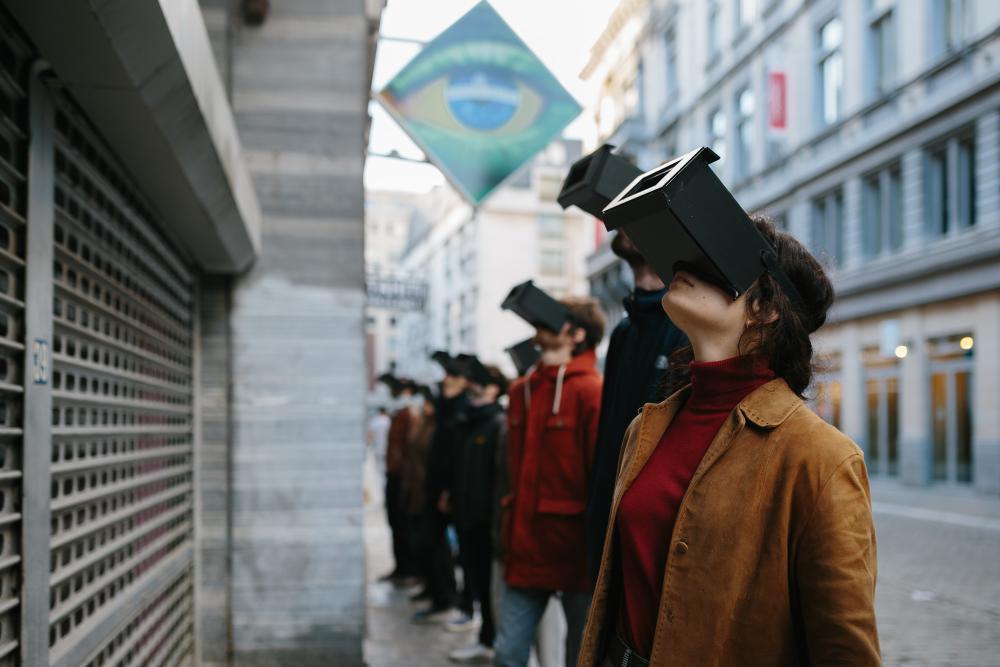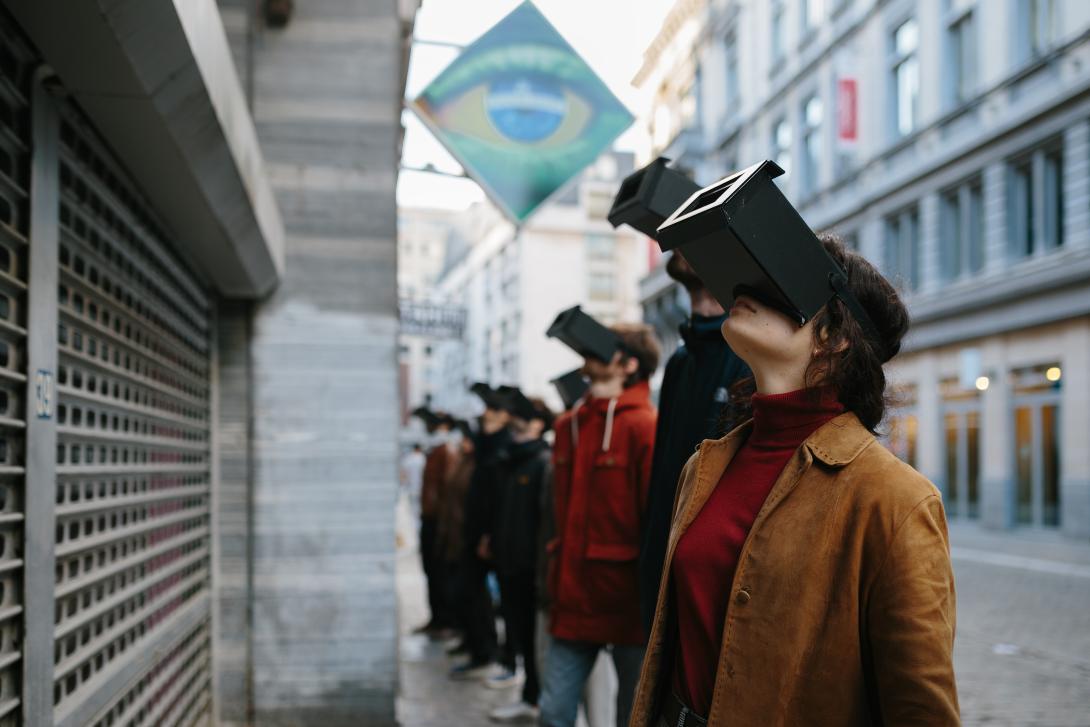Benjamin Vandewalle about Walking the Line
Benjamin Vandewalle in conversation with Marnix Rummens
WHAT IS WALKING THE LINE?
Walking the Line is a choreographed walk through the city. Each participant is given a black viewing box to wear on their head like a mask, framing what they see. Then, hand in hand and in small groups, we set off on a walk but, instead of looking straight ahead, we walk sideways, experiencing our surroundings as if seeing a live travel shot on TV. Various simple instructions mean that you create your own montage of the journey you go on. As often happens in my work for public spaces, Walking the Line is also an invitation to look at everyday reality through the eyes of the theatre, reducing everything to its essence. With Birdwatching 4x4 we drove a theatre gallery through the streets. Walking the Line is a very pure, more tangibly embodied elaboration of the same idea. By means of a very simple intervention you create a mindset that regards the world as a work of art. Rather like Manzoni, who, with his Socle du Monde, turned a simple plinth upside down and declared that the whole world was a work of art.
HOW DOES THIS DIFFER FROM OUR EVERYDAY WAY OF LOOKING AT THE WORLD?
Art and theatre particularly fascinate me because of the state of concentration they are able to bring about. As the audience you enter into a sort of meditative state in which you activate different parts of your brain, create new associations, explore different approaches. In Walking the Line you take time to look differently at everyday life, you pay attention to things that otherwise pass you by almost unnoticed. I think that is something unusual today. In addition, we do it as a group. By holding hands we join together to form one large, collective body, into which part of our individuality is absorbed. You can look about you as if from a strange body. And because you allow yourself to be led you do not have to make many of the social and practical decisions you are normally required to do when walking along, which also produces a different experience. By being in a space in a physically different way reality becomes different too. Like with the spoon in The Matrix, “It's not the spoon that bends, it's only yourself.”
DOES THAT FRAME ALSO CREATE A CERTAIN DISTANCE?
It is a paradox. You are very present in the street scene and in the reality. Yet, at the same time, you experience it from a considerable distance as if watching a film in which you are appearing. By activating both perspectives simultaneously you can bring about something unique. We often find ourselves a bit stuck in everyday situations or in intense emotions or even in examining things too closely. During Walking the Line both aspects of your experience are laid bare. It’s about the contrast. Including in those places that we visit. For each walk we search for a very varied series of locations, both indoors and out, ranging from a wall with graffiti, medieval buildings, a working class bar and an arcade with Thai manicures to a building site… If you walk past without the masks everything flows into everything else but the framing means you see the parts within the whole. You become aware of the incredible diversity, of the things that exist side by side in a micro-universe, how many kinds of life there are, how plural reality is. And it is this that generates profound reflection. As if you encounter something for the first time, an experience of life that falls outside predetermined habits, desires and concepts.
WHAT IS THE IMPORTANCE OF SUCH EXPERIENCES?
Now and then we should step outside our everyday habits to ensure we don’t fall asleep, to ensure we are able to continue to grow. For practical reasons we reduce what we see to a vast system of pattern recognition. But we often forget that that considerably reduces the effective plurality of the reality. Which doesn’t stand still and if we want to be able to continue to respond to it we cannot lose touch with it. Because in other situations we will need other possibilities. That is the paradox of Walking the Line. By imposing a restricting frame and becoming part of a human chain, people’s experience is broadened not narrowed. Many feel themselves becoming very calm during the performance and are surprised at the details they notice. Towards the end we detach people from each other, take back the masks and ask them to go for a walk by themselves, taking the impressions from the performance with them. For many people that is the highlight of the whole thing.
YOU ACHIEVE A NEW WAY OF OBSERVING THINGS
Yes, that is what is so wonderful. What we do is something so simple; you put on a viewing box and hold each other’s hand. But the impact can be really profound. You change speed, change body. You become part of something bigger, both physically by becoming part of the group body and visually by broadening your perspective. Walking the Line is both a visual and a tactile experience. For onlookers too the performance raises questions. Sometimes people find it hard to understand what is going on. They think the boxes are VR glasses but quickly notice that they are empty. Then they think it is a student activity, a sect or some kind of protest. Very few people associate the walkers with a performance. When people stop to watch, an amusing side effect is created. Who is performing for whom? A kind of live interaction comes into being as onlookers look at walkers and walkers at onlookers. Everyone then plays a dual role, that of audience member and performer, actor and observer, you are both active and passive, involved and excluded.
IS THAT A LEITMOTIF IN YOUR RESEARCH AS A CITY CHOREOGRAPHER?
My research as a City Choreographer starts with the question, how can we see our communal public space in a different way? Actively looking plays a very important role in this, yes. Using very simple materials I construct a number of viewing boxes through which to view the urban reality, for example Peri-sphere, a mobile, monumental periscope, or Inter-View, a viewing box in which you look your fellow man straight in the eye. It is important that the creation process occurs in the street, discussion and feedback are then more immediate. In the street you are free from many of the codes and frames of reference of conventional theatre. You are exposed to very diverse reactions, ranging from high praise to hate or apathy. But that keeps your feet firmly on the ground. What interests me is creating new ways of looking. In the theatre we create new worlds but they are often unrelated to reality. Practically too, creation in a public space has many advantages. The space is always available so you are able to work more independently and more flexibly. And it makes touring much easier too.
DOES EACH CITY SET ITS OWN TONE IN WALKING THE LINE?
I have been able to develop Walking the Line all over the world, from Brussels to Johannesburg, from Groningen to Buenos Aires. The performance does, of course, differ from city to city but what surprised me most were the similarities. In all big cities you encounter the same incredible diversity of people, buildings, surroundings, movements… But the audiences and their associations are very different from country to country. In South America religious connotations are much stronger, for example. And you also notice nuances in theatre codes. The traditional Western theatergoer finds the mask easier to deal with and is also used to keeping quiet during a performance. Which is why we rarely improvise. The more rigid it is and the clearer it is, the more the audience is on your side, the more you can carry them along with you. It is this paradox that I find so fascinating, the freedom in restriction, the solidarity in anonymity. No matter how much we believe that our own experience of reality is the reality, it is important to sometimes learn to lose yourself in a different perspective. To reconnect with the reality that transcends our everyday consciousness. Embodied, from the inside out.

